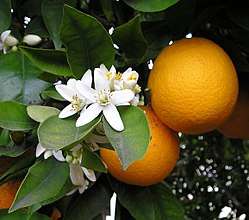Citrus × sinensis
Citrus × sinensis, also known as the Citrus sinensis (Sweet Orange Group), includes the commonly cultivated sweet oranges, including blood oranges and navel oranges.[1]
| Citrus × sinensis | |
|---|---|
 | |
| Scientific classification | |
| Kingdom: | Plantae |
| Clade: | Tracheophytes |
| Clade: | Angiosperms |
| Clade: | Eudicots |
| Clade: | Rosids |
| Order: | Sapindales |
| Family: | Rutaceae |
| Genus: | Citrus |
| Species: | C. × sinensis |
| Binomial name | |
| Citrus × sinensis | |
Uses
The orange fruit is an important agricultural product, used for both the juicy fruit pulp and the aromatic peel (rind). Orange blossoms (the flowers) are used in several different ways, as are the leaves and wood of the tree.
Flowers
- The orange blossom, which is the state flower of Florida,[2] is highly fragrant and traditionally associated with good fortune. It has long been popular in bridal bouquets and head wreaths.
- Orange blossom essence is an important component in the making of perfume.
- Orange blossom petals can also be made into a delicately citrus-scented version of rosewater, known as "orange blossom water" or "orange flower water". It is a common ingredient in French and Middle Eastern cuisines, especially in desserts and baked goods. In some Middle Eastern countries, drops of orange flower water are added to disguise the unpleasant taste of hard water drawn from wells or stored in qullahs (traditional Egyptian water pitchers made of porous clay). In the United States, orange flower water is used to make orange blossom scones and marshmallows.
- In Spain, fallen blossoms are dried and used to make orange tea.
- Orange blossom honey (or citrus honey) is obtained by putting beehives in the citrus groves while trees bloom. By this method, bees also pollinate seeded citrus varieties. This type of honey has an orangey taste and is highly prized.
Leaves
- Orange leaves can be boiled to make orange tea.
Wood
- Orangewood sticks are used as cuticle pushers in manicures and pedicures, and as spudgers for manipulating slender electronic wires.
- Orangewood is used in the same way as mesquite, oak, and hickory for seasoning grilled meat.
 Orange trees in movable pots, so that they can be placed indoors for the winter
Orange trees in movable pots, so that they can be placed indoors for the winter Orange flowers
Orange flowers- Unripened fruit
.jpg) Blood orange
Blood orange- Oranges on the branch
 Orange tree
Orange tree
Chemical composition
Orange fruit and leaf both are reported to contain indole alkaloids including N,N-DMT.
Threats
Giant swallowtail larva
Giant swallowtail caterpillars (Papilio cresphontes) cause serious damage to this crop, especially to young trees.[3]
gollark: <@!340622484674052096>
gollark: !help
gollark: <@!340622484674052096>
gollark: <@!340622484674052096>
gollark: <@!340622484674052096>
References
| Wikimedia Commons has media related to: |
| Wikispecies has information related to Citrus sinensis |
- "Citrus sinensis". Germplasm Resources Information Network (GRIN). Agricultural Research Service (ARS), United States Department of Agriculture (USDA). Retrieved 2015-09-29.
- "Florida State Symbols". Florida Department of State. Division of Historical Resources. Archived from the original on 2014-04-27. Retrieved 2015-09-29.
- "Giant Swallowtail, Orangedog, Papilio cresphontes Cramer (Insecta: Lepidoptera: Papilionidae)1 (PDF Download Available)". ResearchGate. Retrieved 2017-11-14.
External links
- Porcher Michel H.; et al. (1995–2002), Sorting Citrus Names. Multilingual Multiscript Plant Name Database (M.M.P.N.D) - A Work in Progress, The University of Melbourne, Australia
- Xu, Q.; Chen, L.-L.; Ruan, X.; Chen, D.; Zhu, A.; Chen, C.; Bertrand, D.; Jiao, W.-B.; Hao, B.-H.; Lyon, M.P.; Chen, J.; Gao, S.; Xing, F.; Lan, H.; Chang, J.-W.; Ge, X.; Lei, Y.; Hu, Q.; Miao, Y.; Wang, L.; Xiao, S.; Biswas, M.K.; Zeng, W.; Guo, F.; Cao, H.; Yang, X.; Xu, X.-W.; Cheng, Y.-J.; Xu, J.; Liu, J.-H.; Luo, O.J.; Tang, Z.; Guo, W.-W.; Kuang, H.; Zhang, H.-Y.; Roose, M.L.; Nagarajan, N.; Deng, X.-X.; Ruan, Y. (2013), "The draft genome of sweet orange (Citrus sinensis)", Nature Genetics, 45 (1): 59–66, doi:10.1038/ng.2472, PMID 23179022
- Bausher, Michael G; Singh, Nameirakpam D; Lee, Seung-Bum; Jansen, Robert K; Daniell, Henry (2006). "The complete chloroplast genome sequence of Citrus sinensis (L.) Osbeck var 'Ridge Pineapple': Organization and phylogenetic relationships to other angiosperms". BMC Plant Biology. 6: 21. doi:10.1186/1471-2229-6-21. PMC 1599732. PMID 17010212.
This article is issued from Wikipedia. The text is licensed under Creative Commons - Attribution - Sharealike. Additional terms may apply for the media files.